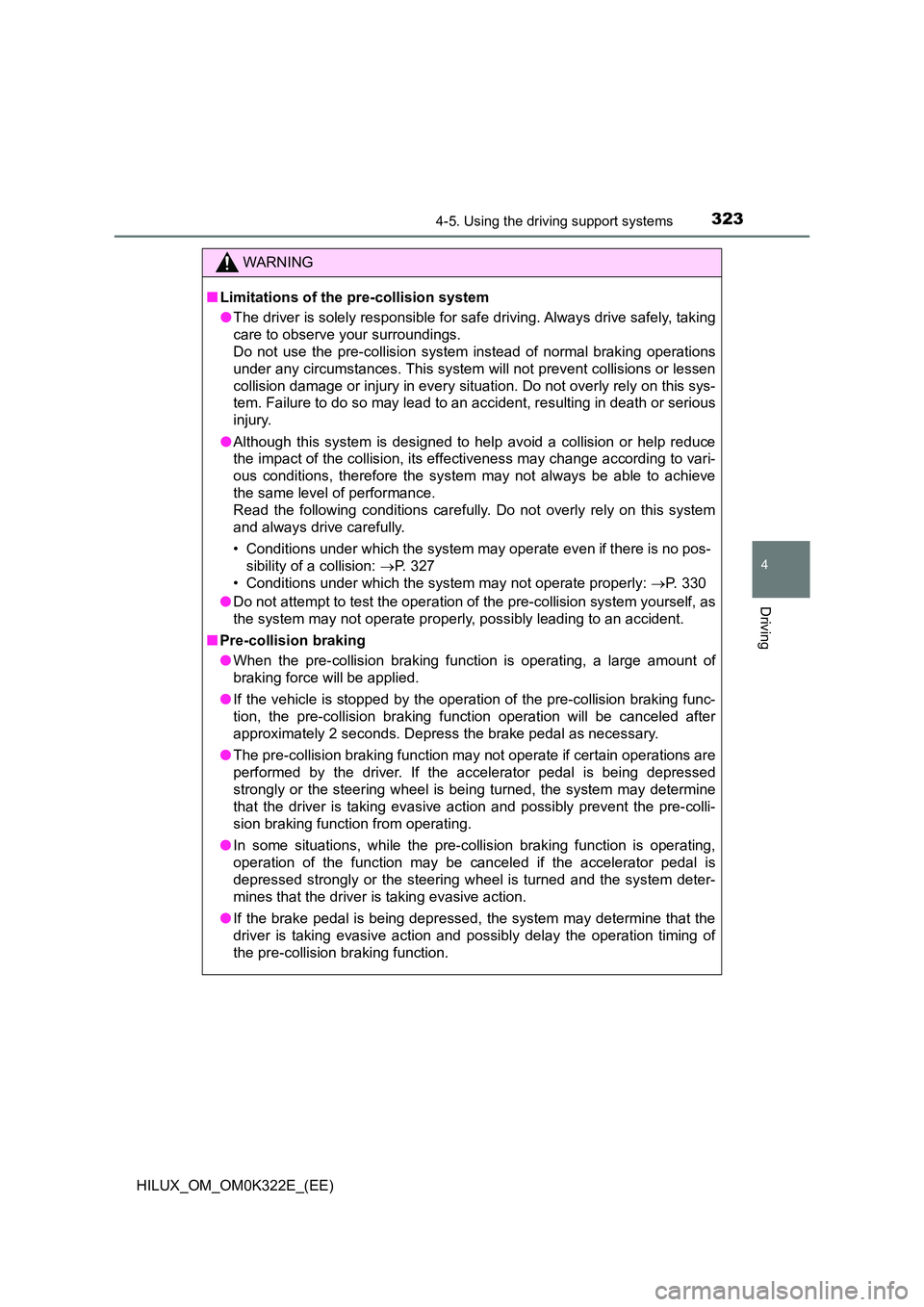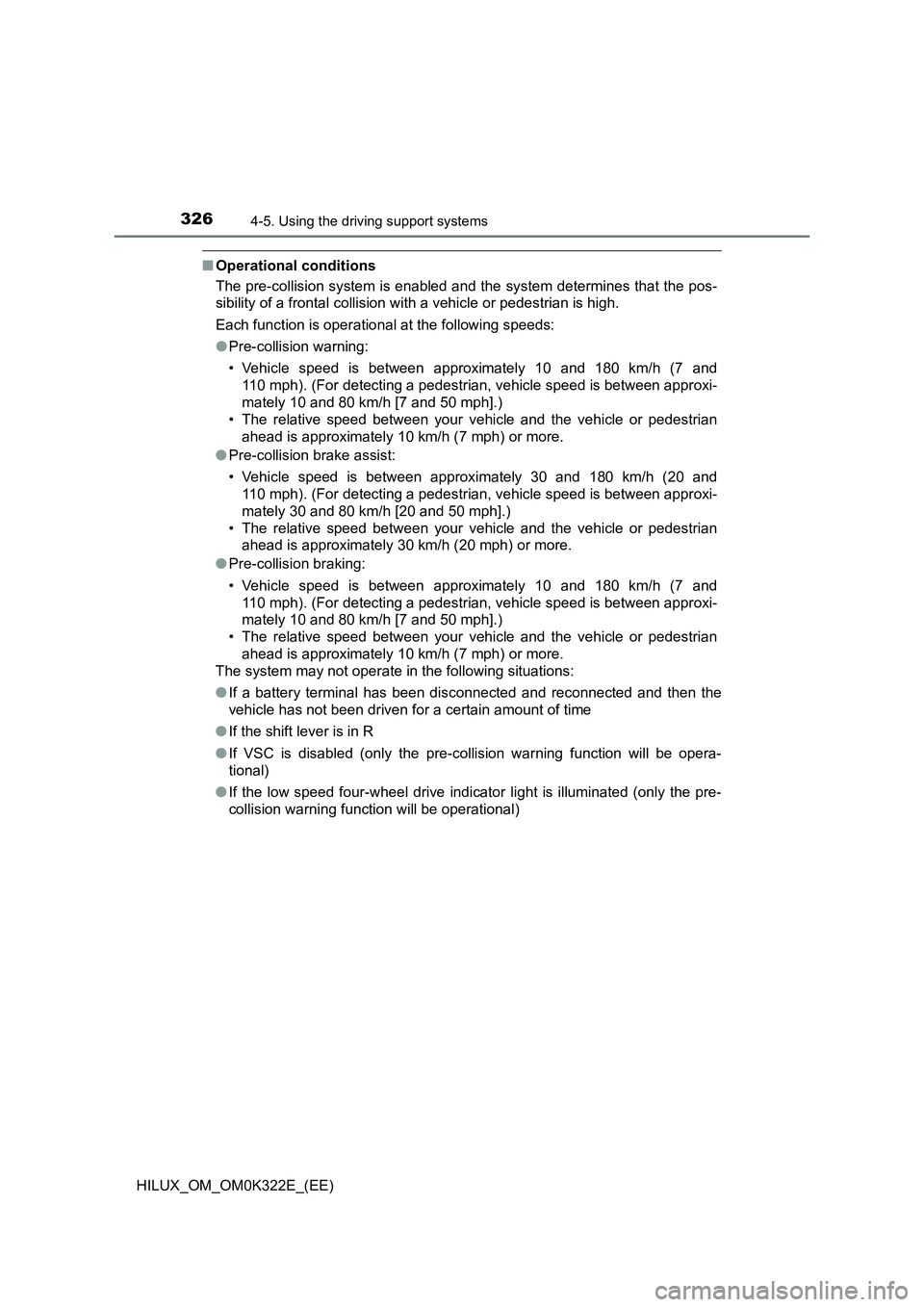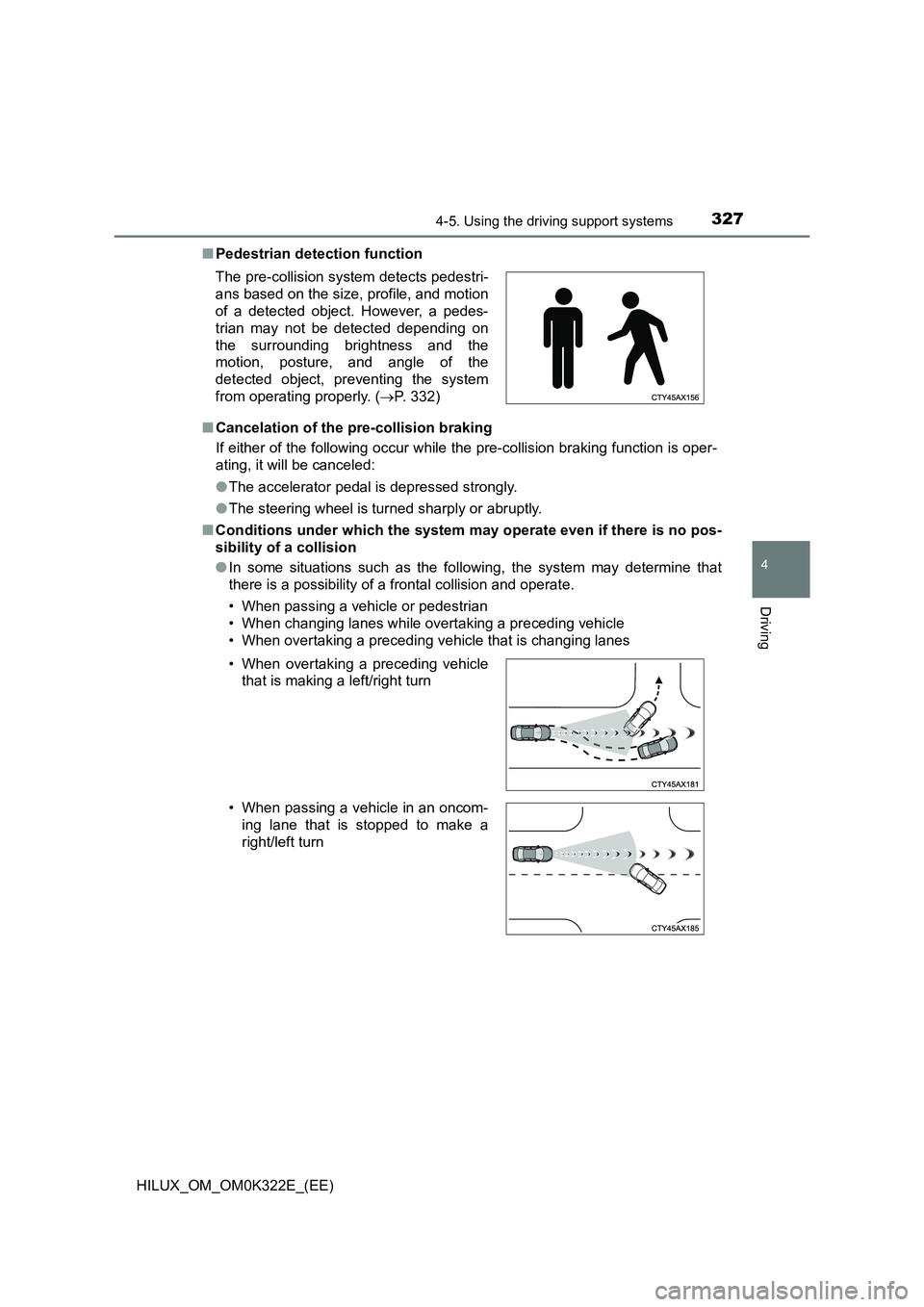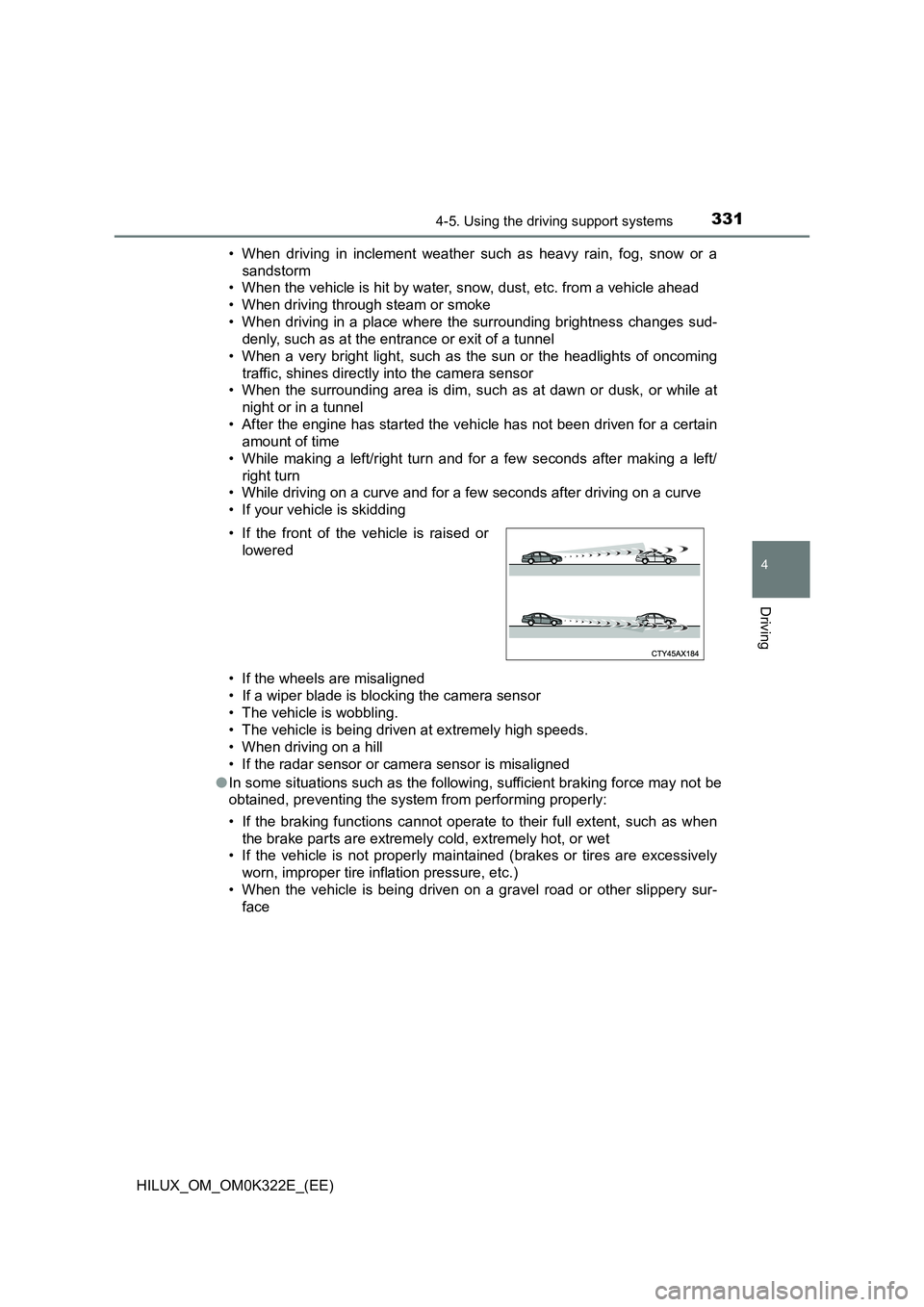Page 286 of 720

2864-2. Driving procedures
HILUX_OM_OM0K322E_(EE)
■Maximum downshifting speeds
Observe the downshifting speeds in the following table to prevent over-rev-
ving the engine.
5-speed transmission
4WD models (front-wheel drive control switch in H2 or H4):
km/h (mph)
*1: TGN126L-DTMSK models*3
*2: TGN126L-DTMLK models*3
*3: See “Checking your vehicle’s model” if you are not sure of which model
your vehicle is. ( P. 11 )
4WD models (front-wheel drive control switch in L4):
km/h (mph)
*1: TGN126L-DTMSK models*3
*2: TGN126L-DTMLK models*3
*3: See “Checking your vehicle’s model” if you are not sure of which model
your vehicle is. ( P. 11 )
Maximum speed
Shift position1234
225/70R17C tires38 (23)71 (44)114 (70)164 (101)
265/65R17 tires39 (24)72 (44)117 (72)168 (104)
205R16C tires39 (24)*1
37 (22)*273 (45)*1
69 (42)*2118 (73)*1
112 (69)*2170 (105)*1
160 (99)*2
Maximum speed
Shift position1234
225/70R17C tires15 (9)28 (17)45 (27)64 (39)
265/65R17 tires15 (9)28 (17)46 (28)65 (40)
205R16C tires15 (9)28 (17)*1
27 (16)*246 (28)*1
44 (27)*266 (41)*1
63 (39)*2
Page 287 of 720
2874-2. Driving procedures
4
Driving
HILUX_OM_OM0K322E_(EE)
6-speed transmission
4WD models (front-wheel drive control switch in H2 or H4):
km/h (mph)
Maximum speed
Shift position12345
2GD-FTV
engine
205R16C
tires34 (21)67 (41)113
(70)
163
(101)
170
(105)
225/70R17C
tires35 (21)69 (42)116
(72)
167
(103)
170
(105)
265/65R17,
265/60R18
tires
36 (22)70 (43)118
(73)
170
(105)
170
(105)
2KD-FTV
engine
205R16C
tires30 (18)59 (36)99 (61)142
(88)
150
(93)
225/70R17C
tires29 (18)57 (35)97 (60)139
(86)
150
(93)
265/65R17
tires30 (18)59 (36)98 (60)142
(88)
150
(93)
Page 288 of 720
2884-2. Driving procedures
HILUX_OM_OM0K322E_(EE)
4WD models (front-wheel drive control switch in L4):
km/h (mph)
Pre Runner:
km/h (mph)
Maximum speed
Shift position 1 2 3 4 5
2GD-FTV
engine
205R16C
tires13 (8)26 (16)44 (27)64 (39)82 (50)
225/70R17C
tires14 (8)27 (16)45 (27)65 (40)84 (52)
265/65R17
tires14 (8)27 (16)46 (28)67 (41)86 (53)
265/60R18
tires14 (8)28 (17)46 (28)67 (41)86 (53)
2KD-FTV
engine
205R16C
tires12 (7)23 (14)39 (24)56 (34)67 (41)
225/70R17C
tires11 ( 6 )22 (13)38 (23)54 (33)66 (41)
265/65R17
tires12 (7)23 (14)38 (23)55 (34)67 (41)
Maximum speed
Shift position12345
225/70R17C tires35 (21)69 (42)116
(72)
167
(103)
175
(108)
265/60R18 tires36 (22)70 (43)118
(73)
171
(106)
175
(108)
265/65R17 tires36 (22)70 (43)118
(73)
170
(105)
175
(108)
Page 323 of 720

3234-5. Using the driving support systems
4
Driving
HILUX_OM_OM0K322E_(EE)
WARNING
■Limitations of the pre-collision system
● The driver is solely responsible for safe driving. Always drive safely, taking
care to observe your surroundings.
Do not use the pre-collision system instead of normal braking operations
under any circumstances. This system will not prevent collisions or lessen
collision damage or injury in every situation. Do not overly rely on this sys-
tem. Failure to do so may lead to an accident, resulting in death or serious
injury.
● Although this system is designed to help avoid a collision or help reduce
the impact of the collision, its effectiveness may change according to vari-
ous conditions, therefore the system may not always be able to achieve
the same level of performance.
Read the following conditions carefully. Do not overly rely on this system
and always drive carefully.
• Conditions under which the system may operate even if there is no pos-
sibility of a collision: P. 327
• Conditions under which the system may not operate properly: P. 3 3 0
● Do not attempt to test the operation of the pre-collision system yourself, as
the system may not operate properly, possibly leading to an accident.
■ Pre-collision braking
● When the pre-collision braking function is operating, a large amount of
braking force will be applied.
● If the vehicle is stopped by the operation of the pre-collision braking func-
tion, the pre-collision braking func tion operation will be canceled after
approximately 2 seconds. Depress the brake pedal as necessary.
● The pre-collision braking function may not operate if certain operations are
performed by the driver. If the accelerator pedal is being depressed
strongly or the steering wheel is bei ng turned, the system may determine
that the driver is taking evasive action and possibly prevent the pre-colli-
sion braking function from operating.
● In some situations, while the pre-collision braking function is operating,
operation of the function may be canceled if the accelerator pedal is
depressed strongly or the steering wheel is turned and the system deter-
mines that the driver is taking evasive action.
● If the brake pedal is being depressed, the system may determine that the
driver is taking evasive action and possibly delay the operation timing of
the pre-collision braking function.
Page 324 of 720

3244-5. Using the driving support systems
HILUX_OM_OM0K322E_(EE)
WARNING
■When to disable the pre-collision system
In the following situations, disable the system, as it may not operate prop-
erly, possibly leading to an accident resulting in death or serious injury:
● When the vehicle is being towed
● When your vehicle is towing another vehicle
● When transporting the vehicle via truck, boat, train or similar means of
transportation
● When the vehicle is raised on a lift with the engine running and the tires
are allowed to rotate freely
● When inspecting the vehicle using a drum tester such as a chassis dyna-
mometer or speedometer tester, or when using an on vehicle wheel bal-
ancer
● When a strong impact is applied to the front bumper or front grille, due to
an accident or other reasons
● If the vehicle cannot be driven in a stable manner, such as when the vehi-
cle has been in an accident or is malfunctioning
● When the vehicle is driven in a sporty manner or off-road
● When the tires are not properly inflated
● When the tires are very worn
● When tires of a size other than specified are installed
● When tire chains are installed
● When a compact spare tire or an emergency tire puncture repair kit is used
● If equipment (snow plow, etc.) that may obstruct the radar sensor or cam-
era sensor is temporarily installed to the vehicle
Page 326 of 720

3264-5. Using the driving support systems
HILUX_OM_OM0K322E_(EE)
■Operational conditions
The pre-collision system is enabled and the system determines that the pos-
sibility of a frontal collision wi th a vehicle or pedestrian is high.
Each function is operational at the following speeds:
● Pre-collision warning:
• Vehicle speed is between approximately 10 and 180 km/h (7 and
110 mph). (For detecting a pedestrian, vehicle speed is between approxi-
mately 10 and 80 km/h [7 and 50 mph].)
• The relative speed between your vehicle and the vehicle or pedestrian
ahead is approximately 10 km/h (7 mph) or more.
● Pre-collision brake assist:
• Vehicle speed is between approximately 30 and 180 km/h (20 and
110 mph). (For detecting a pedestrian, vehicle speed is between approxi-
mately 30 and 80 km/h [20 and 50 mph].)
• The relative speed between your vehicle and the vehicle or pedestrian
ahead is approximately 30 km/h (20 mph) or more.
● Pre-collision braking:
• Vehicle speed is between approximately 10 and 180 km/h (7 and
110 mph). (For detecting a pedestrian, vehicle speed is between approxi-
mately 10 and 80 km/h [7 and 50 mph].)
• The relative speed between your vehicle and the vehicle or pedestrian
ahead is approximately 10 km/h (7 mph) or more.
The system may not operate in the following situations:
● If a battery terminal has been disconnected and reconnected and then the
vehicle has not been driven for a certain amount of time
● If the shift lever is in R
● If VSC is disabled (only the pre-collision warning function will be opera-
tional)
● If the low speed four-wheel drive indicator light is illuminated (only the pre-
collision warning function will be operational)
Page 327 of 720

3274-5. Using the driving support systems
4
Driving
HILUX_OM_OM0K322E_(EE)
■ Pedestrian detection function
■ Cancelation of the pre-collision braking
If either of the following occur while the pre-collision braking function is oper-
ating, it will be canceled:
● The accelerator pedal is depressed strongly.
● The steering wheel is turned sharply or abruptly.
■ Conditions under which the system may operate even if there is no pos-
sibility of a collision
● In some situations such as the following, the system may determine that
there is a possibility of a frontal collision and operate.
• When passing a vehicle or pedestrian
• When changing lanes while overtaking a preceding vehicle
• When overtaking a preceding vehicle that is changing lanes
The pre-collision system detects pedestri-
ans based on the size, profile, and motion
of a detected object. However, a pedes-
trian may not be detected depending on
the surrounding brightness and the
motion, posture, and angle of the
detected object, preventing the system
from operating properly. ( P. 332)
• When overtaking a preceding vehicle
that is making a left/right turn
• When passing a vehicle in an oncom-
ing lane that is stopped to make a
right/left turn
Page 331 of 720

3314-5. Using the driving support systems
4
Driving
HILUX_OM_OM0K322E_(EE)
• When driving in inclement weather such as heavy rain, fog, snow or a
sandstorm
• When the vehicle is hit by water, snow, dust, etc. from a vehicle ahead
• When driving through steam or smoke
• When driving in a place where the surrounding brightness changes sud-
denly, such as at the entrance or exit of a tunnel
• When a very bright light, such as the sun or the headlights of oncoming
traffic, shines directly into the camera sensor
• When the surrounding area is dim, such as at dawn or dusk, or while at
night or in a tunnel
• After the engine has started the vehicle has not been driven for a certain
amount of time
• While making a left/right turn and for a few seconds after making a left/
right turn
• While driving on a curve and for a few seconds after driving on a curve
• If your vehicle is skidding
• If the wheels are misaligned
• If a wiper blade is blocking the camera sensor
• The vehicle is wobbling.
• The vehicle is being driven at extremely high speeds.
• When driving on a hill
• If the radar sensor or camera sensor is misaligned
● In some situations such as the following, sufficient braking force may not be
obtained, preventing the system from performing properly:
• If the braking functions cannot operate to their full extent, such as when
the brake parts are extremely cold, extremely hot, or wet
• If the vehicle is not properly maintained (brakes or tires are excessively
worn, improper tire inflation pressure, etc.)
• When the vehicle is being driven on a gravel road or other slippery sur-
face
• If the front of the vehicle is raised or
lowered